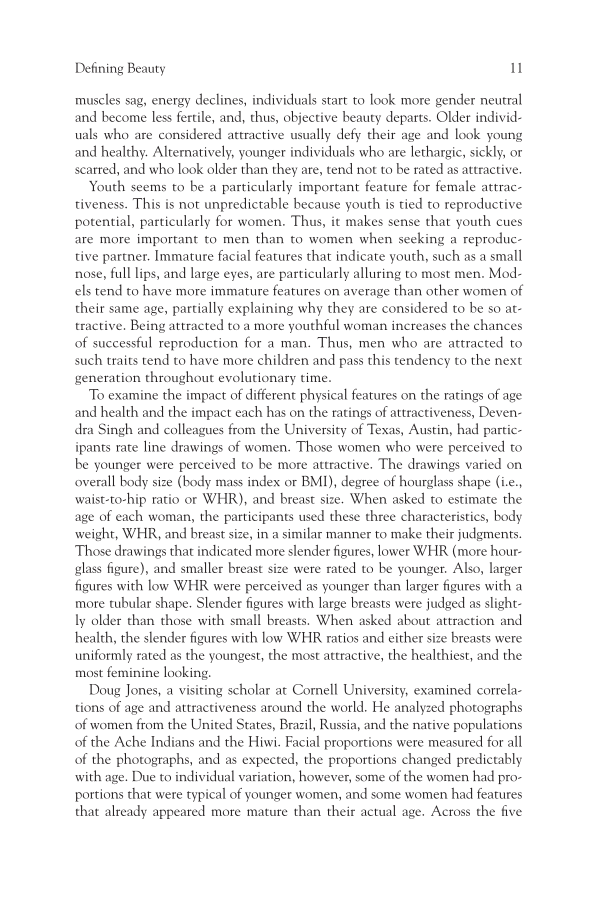Defining Beauty 11 muscles sag, energy declines, individuals start to look more gender neutral and become less fertile, and, thus, objective beauty departs. Older individ- uals who are considered attractive usually defy their age and look young and healthy. Alternatively, younger individuals who are lethargic, sickly, or scarred, and who look older than they are, tend not to be rated as attractive. Youth seems to be a particularly important feature for female attrac- tiveness. This is not unpredictable because youth is tied to reproductive potential, particularly for women. Thus, it makes sense that youth cues are more important to men than to women when seeking a reproduc- tive partner. Immature facial features that indicate youth, such as a small nose, full lips, and large eyes, are particularly alluring to most men. Mod- els tend to have more immature features on average than other women of their same age, partially explaining why they are considered to be so at- tractive. Being attracted to a more youthful woman increases the chances of successful reproduction for a man. Thus, men who are attracted to such traits tend to have more children and pass this tendency to the next generation throughout evolutionary time. To examine the impact of different physical features on the ratings of age and health and the impact each has on the ratings of attractiveness, Deven- dra Singh and colleagues from the University of Texas, Austin, had partic- ipants rate line drawings of women. Those women who were perceived to be younger were perceived to be more attractive. The drawings varied on overall body size (body mass index or BMI), degree of hourglass shape (i.e., waist-to-hip ratio or WHR), and breast size. When asked to estimate the age of each woman, the participants used these three characteristics, body weight, WHR, and breast size, in a similar manner to make their judgments. Those drawings that indicated more slender figures, lower WHR (more hour- glass figure), and smaller breast size were rated to be younger. Also, larger figures with low WHR were perceived as younger than larger figures with a more tubular shape. Slender figures with large breasts were judged as slight- ly older than those with small breasts. When asked about attraction and health, the slender figures with low WHR ratios and either size breasts were uniformly rated as the youngest, the most attractive, the healthiest, and the most feminine looking. Doug Jones, a visiting scholar at Cornell University, examined correla- tions of age and attractiveness around the world. He analyzed photographs of women from the United States, Brazil, Russia, and the native populations of the Ache Indians and the Hiwi. Facial proportions were measured for all of the photographs, and as expected, the proportions changed predictably with age. Due to individual variation, however, some of the women had pro- portions that were typical of younger women, and some women had features that already appeared more mature than their actual age. Across the five
Document Details My Account Print multiple pages
Print
You have printed 0 times in the last 24 hours.
Your print count will reset on at .
You may print 0 more time(s) before then.
You may print a maximum of 0 pages at a time.


















































































































































































































































































